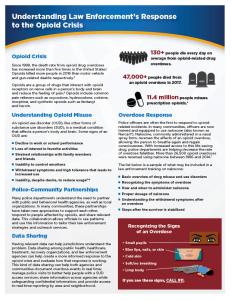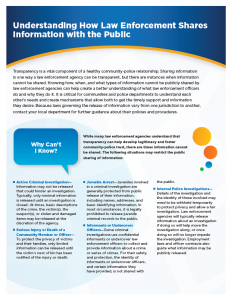Educational Resources for Law Enforcement and the Community
To help educate the public on important public safety issues and to foster communication between law enforcement and communities, the International Association of Chiefs of Police (IACP) and the U.S. Department of Justice’s Office of Community Oriented Policing Services produced a series of resources. These resources were produced under the Enhancing Officer Safety Through Increase Respect for Law Enforcement project and include a series of podcasts, fact sheets, and a DiscoverPolicing.org postcard for sworn and non-law enforcement audiences to use as an educational tool.
Podcasts Series
Through the Lenses: Law Enforcement Body-Worn Cameras
Listen to Chief Luis Soler from the Woodland, California Police Department and Dr. Wesley G. Jennings, a professor in the School of Criminal Justice at Texas State University, discuss the usage and implementation of body-worn cameras in police departments. Transcript
Public Recording of Police: Considerations for Law Enforcement and Communities
Chief Billy Grogan from the City of Dunwoody, Georgia Police Department and Mr. Mickey Osterreicher on the General Counsel for the NPPA, discuss the legalities of the public’s right to record police. Mickey and Chief Grogan touch on the current climate around recording police and how it has made an impact in police and community relations. Transcript
Drones in Law Enforcement
Captain Time Martin from the Huntington Beach California Police Department discusses the functions and use of drones by law enforcement and the success and challenges they face with this new tool. Transcript
The CSI Effect: Inside Criminal Justice Forensic Investigations
Deputy Director Janet Girten, from the Colorado Bureau of Investigations discusses promising practices in modern forensics investigations and how they fit into policing and the larger criminal justice system. The podcast also highlights processes and protocols for effective evidence management and how forensic investigators can better coordinate with law enforcement in solving crimes.Transcript
Demonstrations on University and College Campuses: Law Enforcement’s Role in Planning and Response
Chief John Vinson of the University of Washington Police Department and Dr. Tamara Herold from the University of Nevada, Las Vegas discuss promising practices for police to use when planning and responding to university and college demonstrations. The podcast also includes research-based considerations for safety and crowd control during demonstrations. Transcript
This project was supported, in whole or in part, by cooperative agreement number 2017CKWXK004 awarded by the U.S. Department of Justice, Office of Community Oriented Policing Services. And as always, the opinions contained herein are those of the speakers and do not represent the official position or polices of the U.S. Department of Justice. References to specific individuals, agencies, companies, products, or services should not be considered an endorsement by the speakers, IACP, or the U.S. Department of Justice. Rather, the references are illustrations to supplement discussion of the issues.
Fact Sheet Series
The series features fact sheets to help people understand the structure, ranks, roles, and standard equipment of law enforcement agencies that serve them. The series also includes information on public safety topics like body worn cameras, public information sharing, and the opioid epidemic.
 Understanding Law Enforcement's Use of Body-Worn Cameras
Understanding Law Enforcement's Use of Body-Worn Cameras
The rapid and widespread adoption of BWC's has contributed to some misconceptions about their use, function, and effects on police-public relationships. This fact sheet will present information about body-worn cameras.
 Law Enforcement Equipment Basics
Law Enforcement Equipment Basics
Law enforcement is a unique job that entails using different equipment for different situations. This fact sheet provides information on the different equipment officers use to protect their communities.
 Badge Basics: Types of Law Enforcement Agencies
Badge Basics: Types of Law Enforcement Agencies
There are different agency types in the United states; federal, state, local, and tribal law enforcement agencies. These agencies provide different services to the public. This fact sheet explores the most common law enforcement agencies.
 Understanding Law Enforcement's Response to the Opioid Crisis
Understanding Law Enforcement's Response to the Opioid Crisis
Police Offices are often the first to respond to opioid related incidents. This fact sheet provides general insight on law enforcement's role and responsibilities in response to the opioid crisis.
 Understanding How Law Enforcement Shares Information with the Public
Understanding How Law Enforcement Shares Information with the Public
Sharing information is a vital component in healthy community-police relationships. This fact sheet will highlight how, when, and what types of information can/cannot be publicly share by law enforcement agencies.
 Behind the Badge: Law Enforcement Units, Ranks, and Roles
Behind the Badge: Law Enforcement Units, Ranks, and Roles
Each police department is unique and may use different names and terms for their units, ranks, and roles. This fact sheet provides a general introduction of the typical duties of most law enforcement officers.
Discover Policing Postcard
DiscoverPolicing.org helps law enforcement find, attract, and hire quality candidates from diverse backgrounds. By promoting policing as a career and by helping agencies connect with interested, informed candidates and community members, DiscoverPolicing.org makes important connections to help build relationships and meet today’s public safety needs.
Check out the new Discover Policing Postcard to use in your recruitment efforts

